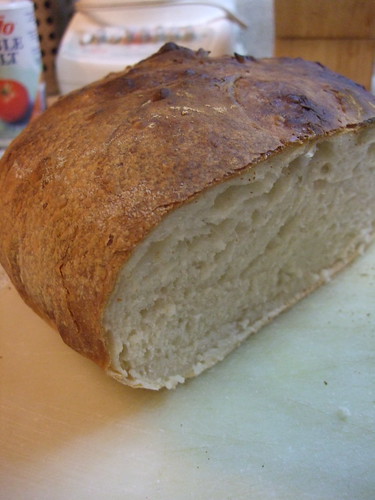I had no container in which I could bake the bread. Baking the bread in a dutch oven or a cast-iron pot keeps the steam in with the bread, making the crust nice and chewy, like real French bread. So in the end, after shaping and resting the bread, I baked it directly on my baking stone, using a tray of ice cubes on the bottom shelf to create steam. The crust was nice and chewy but the crumb left something to be desired, even after having risen for 24 hours. The flavour was good, but wasn't very salty, and didn't have the lovely nutty texture a long rise usually gives.

If you want to make delicious French bread and have absolutely no time whatsoever to be at home and supervise, then for sure, go this way. You'll get rave reviews and people will still love you.
But, if you have a day when you're going to be home anyways, working or doing chores, or watch TV etc, then I suggest you follow this method. This bread is almost as easy, does not require a dutch oven (although I'm sure it would be nice baked in there, too!), and can be shaped into lovely baguettes which are useful for impressing boyfriends, guests, et al.

If you can't see the recipe, first of all you should join The Fresh Loaf because it's awesome, but I'll reproduce it here, too.
Poolish
1 cup flour
1 cup water
1/4 teaspoon instant yeast
Final Dough
1 pound flour (about 4 cups)
10-12 ounces water (by weight, not volume!)
1 teaspoon instant yeast
2 teaspoons salt
all of the poolish
Combine the ingredients for the poolish in a small bowl the night before baking. Cover the bowl with plastic wrap and leave the poolish out at room temperature overnight.
The next day, prepare the final dough. Combine all the ingredients except for the poolish in a bowl and let it sit for 25 minutes. This develops the gluten in the bread and makes nice holes in the crumb. Then add the poolish in and mix them together until you have a VERY wet dough. Your hands will look like you put them in ... well, a lot of flour and water.
Knead the dough as best you can. Then put the dough in an oiled bowl, cover it, then leave it for 45-60 minutes. Come back and fold it ever 45 minutes to an hour, so about 6 times.
Shape the dough how ever you like and put the shaped loaves on parchment paper to rise. The Fresh Loaf has great shaping tutorials, not to mention more tips and tricks for French Bread. I usually make two oval loaves out of this amount of ingredients. Cover your loaves and let them rise for another 90 minutes. Meanwhile, preheat your oven to as hot as it can safely go. I usually set mine to 450-475, with my baking stone in right from the start.
Right before you're going to pop those loaves in, get the sharpest knife you have, or a razor blade, and make some slashes about 1/2" deep along the length of the bread. This will help the bread rise up and not split at the bottom. Bake for about 20 minutes. As you put the loaves in, put in a baking dish full of ice cubes. After 5 minutes, turn the temperature down to 450. The loaves should be brown and toasty on the top and sound hollow on the bottom when tapped.
Even though you're going to want to bite those loaves right out of the oven, resist. Leave them cool until they're mostly cold, and only then slice them. The gluten strands that make French bread so delicious continue to develop until the bread is cool. You'll end up with gummy crumb if you cut it too early.
See also: Naan Bread
















Wow, you're not kidding about the wetness!
ReplyDeleteYep, it's pretty wet! If it's sooooo runny runny that it won't rise or shape, add a *titch* more flour while you're folding, but it should be quite wet indeed. As in, unkneadable. :)
ReplyDelete